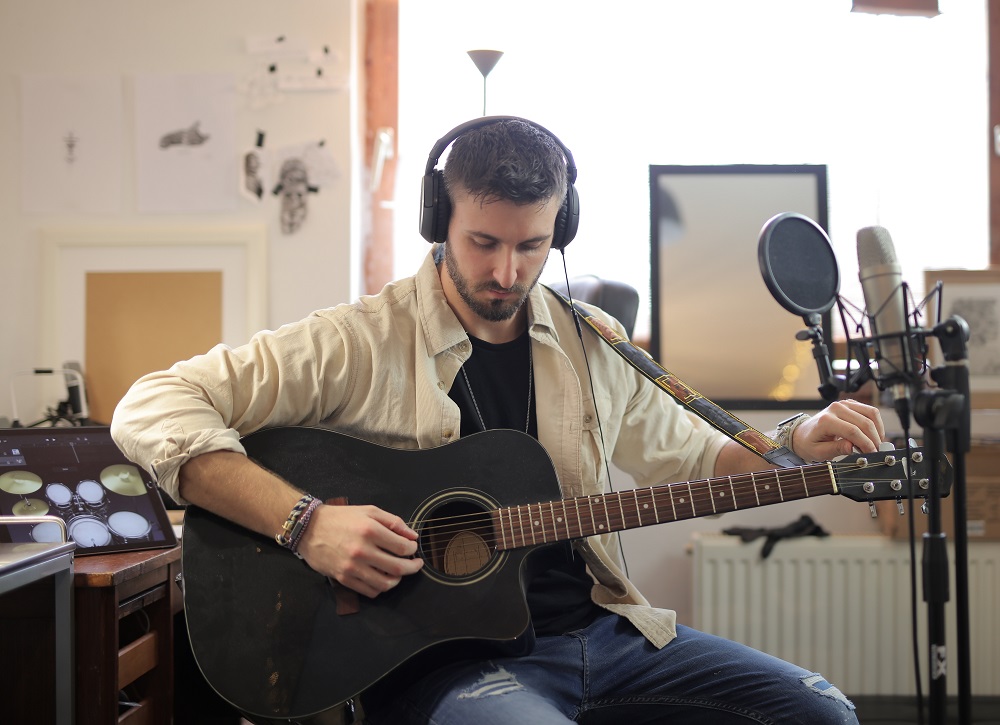
Recording your guitar is an exciting and essential part of the music production process. Whether you’re a professional musician or an enthusiastic hobbyist, capturing the sound of your guitar accurately and with high quality is crucial. To achieve this, you need the right equipment for studio and home recording. In this article, we will explore the best equipment options to help you get started on your guitar recording journey.
1. Audio Interface:
An audio interface is the central hub for connecting your guitar to your computer or recording device. It converts the analog signal from your guitar into a digital format that can be recorded and processed. When choosing an audio interface, consider the number of inputs you need (usually one or two for recording guitar), the quality of the preamps, and the connectivity options such as USB or Thunderbolt.
Recommended audio interfaces for guitar recording:
- Focusrite Scarlett 2i2
- PreSonus AudioBox USB
- Universal Audio Apollo Twin
2. Microphones:
Microphones play a vital role in capturing the sound of your guitar, especially when recording with an acoustic guitar or miking up guitar amplifiers. There are two primary microphone types to consider:
Dynamic microphones: These microphones are robust and can handle high sound pressure levels. They are ideal for close-miking electric guitar amplifiers and capturing the punch and clarity of the sound.
Recommended dynamic microphones for guitar recording:
- Shure SM57
- Sennheiser e609
Condenser microphones: Condenser microphones are more sensitive and capture a broader frequency range. They are commonly used for recording acoustic guitars and capturing the natural nuances of the instrument’s sound.
Recommended condenser microphones for guitar recording:
- Audio-Technica AT2020
- Rode NT1
3. Virtual Amp Simulators:
Virtual amp simulators are software or hardware devices that emulate the sound of guitar amplifiers and cabinets. They allow you to access a wide range of amp models and effects without the need for physical equipment. Virtual amp simulators are particularly useful for home recording setups or situations where using a real amplifier is not feasible.
Recommended virtual amp simulators for guitar recording:
- Line 6 Helix Native
- Positive Grid Bias FX 2
- Native Instruments Guitar Rig
4. Direct Recording Solutions:
If you prefer a straightforward and hassle-free recording setup, direct recording solutions might be the best option for you. These devices allow you to connect your guitar directly to your recording interface, bypassing the need for amplifiers or microphones. Direct recording solutions often include amp modeling and effects processing, giving you a range of sounds to choose from.
Recommended direct recording solutions for guitar recording:
- Line 6 POD HD500X
- Kemper Profiler
- Fractal Audio Axe-Fx III
5. Studio Monitors or Headphones:
To accurately monitor and mix your guitar recordings, you need a good pair of studio monitors or headphones. Studio monitors provide a flat frequency response, allowing you to hear your recordings as accurately as possible. Headphones offer a more isolated listening experience and are ideal for late-night recording sessions or when you need to focus on details without disturbing others.
Recommended studio monitors for guitar recording:
- Yamaha HS5
- KRK Rokit RP5
- JBL LSR305
Recommended headphones for guitar recording:
- Audio-Technica ATH-M50x
- Sennheiser HD 650
- Beyerdynamic DT 770 Pro
6. Recording Software:
Lastly, you’ll need recording software, also known as a digital audio workstation (DAW), to capture, edit, and mix your guitar recordings. There are several DAW options available, each with its own set of features and workflows. Some recommended recording software options for guitar recording include:
- Pro Tools: Known as the industry standard, Pro Tools offers powerful recording, editing, and mixing capabilities.
- Ableton Live: Popular among electronic musicians, Ableton Live provides a flexible and intuitive interface for recording and live performance.
- Logic Pro: Designed specifically for Mac users, Logic Pro offers a comprehensive set of tools for recording, editing, and mixing music.
- Reaper: A highly customizable and affordable option, Reaper is a versatile DAW suitable for both beginners and professionals.
- Cubase: Cubase provides a range of features for recording, editing, and mixing, making it a reliable choice for guitarists.
Remember to choose a recording software that suits your workflow and preferences. Many DAWs offer trial versions, allowing you to test them out before making a final decision.
7. Cables and Accessories:
To ensure a clean and reliable signal flow, invest in high-quality instrument cables to connect your guitar to the audio interface or direct recording device. Additionally, consider accessories such as a guitar stand, pop filter (for vocal recording while playing guitar), and a comfortable chair or stool for extended recording sessions.
It’s worth noting that the best equipment for guitar recording ultimately depends on your specific needs, budget, and recording environment. Experimenting with different combinations of equipment can help you find the setup that best suits your playing style and desired sound.
Recording your guitar requires the right equipment to capture the essence of your playing accurately. Start with a reliable audio interface, suitable microphones, and consider the option of virtual amp simulators or direct recording solutions. Choose studio monitors or headphones for accurate monitoring and invest in recording software that aligns with your workflow. Don’t forget essential accessories and cables to ensure a smooth recording process. With the right equipment, you can embark on an exciting guitar recording journey, capturing your music with professional quality.
Generated by ChatGPT